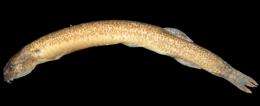Smallest eel-loach fish discovered

(PhysOrg.com) -- The world's smallest species of eel-loach fish has been discovered by a Natural History Museum scientist and his colleague this month and is featured on the Museum's Species of the day today.
The tiny eel-shaped fish from Laos grows to just over 20mm and was named Pangio longimanus by the Museum's ichthyologist (fish expert) Dr Ralf Britz and Dr Maurice Kottelat of the National University Singapore.
Pangio longimanus means 'long hand' and was given to the species because the males have very long pectoral fins that stretch to 16% of their body length - the average for the Pangio genus is 10%.
Although this miniature eel-loach is tiny, it is more than double the size of the world's smallest fish, Paedocypris progenetica, which is 7.9mm long.
Both of these fishes are classed as miniature as they measure less than 26mm. Another famous tiny species recently discovered is Danionella dracula, the 17mm-long fish of the carp family with spectacular tooth-like structures.
P. longimanus belongs to the Pangio genus, the eel-loaches. They are popular aquarium fish, often found swimming at the bottom of tanks. In the wild they live in leaf litter and mud at the bottom of streams and rivers.
There are 32 species of Pangio in the world, found only in India, Myanmar, Indochina and the Sunda Islands, but there are likely to be many more undiscovered.
Dr Britz explains his surprise of the discovery. ‘I had revised the Myanmar Pangio before and knew about the underestimated diversity in that genus, but the discovery of a miniature eel-loach was really unexpected.’
‘I had worked quite a bit on miniature cyprinids (carp-like fishes such as P. progenetica and D. dracula) before and if one had asked me if there was a miniature Pangio out there, I would have said no.’
The identification of this miniature eel-loach highlights the huge numbers of species on our planet still to discover. Each year 300-400 new fish species are being added to the already known 30,000 species. Scientists have identified about 1.8 million species of organisms so far but estimates say that there are likely to be between 5-50million!
P. longimanus is a new species of freshwater fish. It was collected in 1997 from a large pool where two rivers meet and flow into the Mekong floodplain in Central Laos. This is the only place it is known but it is possible that it exists in other areas in the region.
However, the original site is now downstream from the new Nam Leuk Dam, which will affect the water flow and habitat of the area. Because so little is known about its distribution, its conservation status is unknown.
This fish discovery stresses again how changes to, or the loss of, natural habitats can threaten the survival of species that live there, whether we know about them or not.
To be sure the fish was a new species, Ralf and Maurice compared their specimen with specimens from the vast Museum collections of the Natural History Museum and of other museums. They also took detailed measurements and researched other studies of similar fish.
The results showed that P. longimanus is the smallest in its genus, Pangio, with adults growing to less than 23mm. It is between 5 and 100mm smaller than other species in the group.
Miniaturisation is an evolutionary process that leads to dwarfed sexually mature organisms.
Both D. dracula and P. progenetica became miniature by a process called developmental truncation. This is an evolutionary process where the last stages of the development of an ancestor are cut off in the descendant. Over time, these changes lead to the evolution of new body characteristics and new species, resulting in an adult that looks like an early developmental stage but with mature gonads.
This is something that P. longimanus may have in common with P. progenetica and D. dracula, but it will require further research to confirm this.
Pangio longimanus was scientifically described for the first time this month in the journal Ichthyological Exploration of Freshwaters.
More information: www.pfeilbook.com/04biol/e9902d20.php
Provided by American Museum of Natural History
















